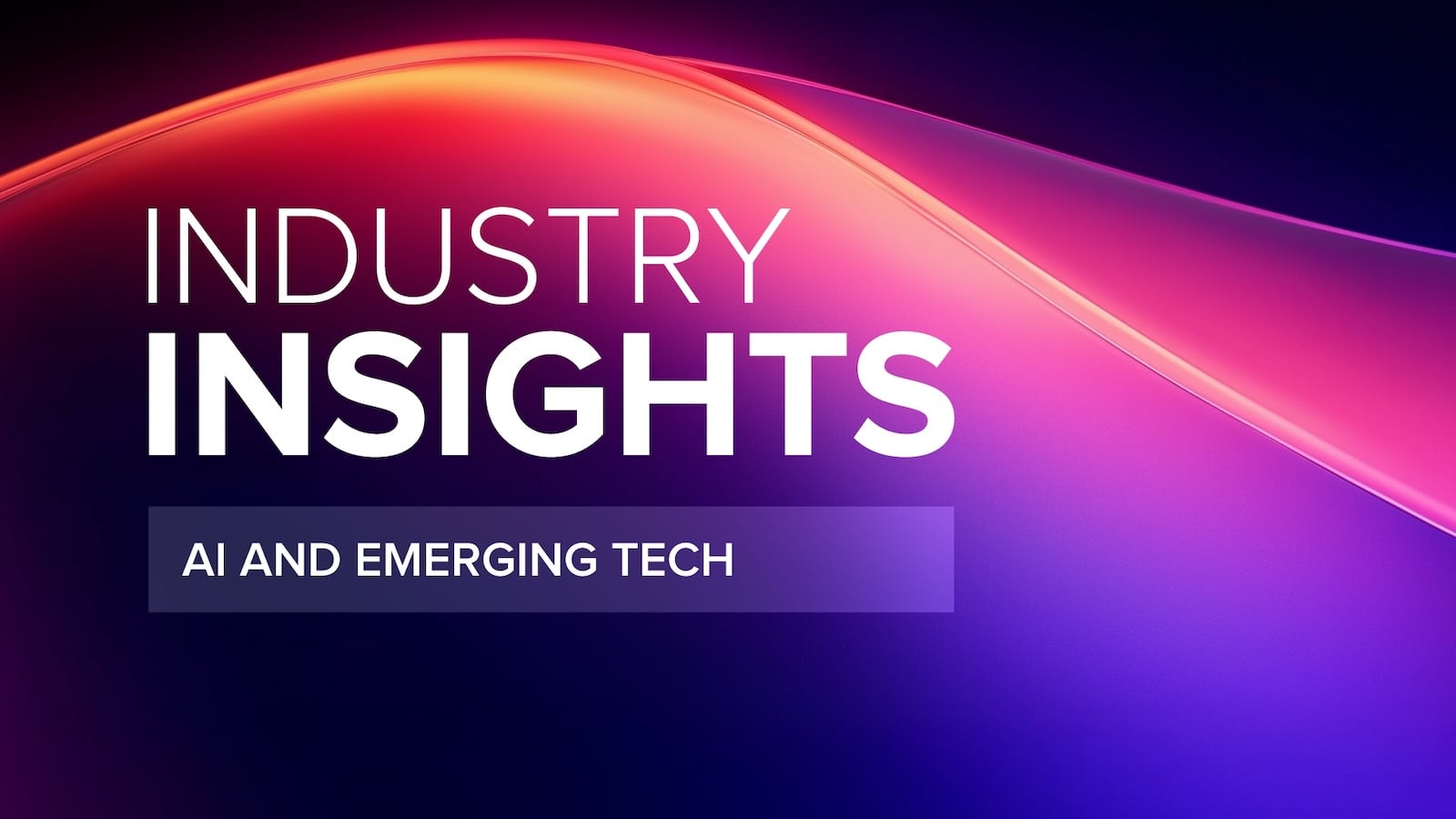Industry Insights: The state of AI in broadcasting and production

Subscribe to NCS for the latest news, project case studies and product announcements in broadcast technology, creative design and engineering delivered to your inbox.
Artificial intelligence continues to reshape broadcast technology, moving beyond theoretical applications to practical implementations across production workflows.
In this first installment of a three-part Industry Insights roundtable, technology vendors and solutions providers examine the current state of AI in broadcast.
The discussion explores real-world applications such as automated captioning, content tagging and live production assistance. Participants address the opportunities and challenges facing broadcasters as they integrate AI tools, from infrastructure requirements to staff training needs. The conversation also looks ahead to emerging AI applications in accessibility, language translation and workflow optimization.
Key takeaways from this Industry Insights roundtable
- Automation: AI technologies now handle routine broadcast tasks including captioning, metadata tagging, and content indexing, allowing staff to focus on creative work.
- Infrastructure: Organizations face significant barriers in AI adoption, including high implementation costs, technical infrastructure requirements, and the need for specialized expertise.
- Live Production: AI enhances live broadcasts through automated camera tracking, real-time analytics, and automated quality control systems.
- Integration: Successfully implementing AI requires careful assessment of existing system compatibility and comprehensive staff training programs.
- Development: Future AI applications in broadcasting focus on improving accessibility features, expanding language translation capabilities, and automating content creation processes.
It’s been a wild year of AI advancements. Where are we today? How do those apply to broadcasters and production?
Siddarth Gupta, principal engineer, Interra Systems: Over the past year, AI has made remarkable strides in natural language processing (NLP), image generation, and real-time analytics, all of which continue to reshape how content is produced and delivered. Broadcasters can now automate routine tasks like editing, captioning, and highlight creation, freeing staff to focus on higher-level storytelling. As a result, production cycles are faster, more data driven, and better aligned with evolving audience preferences.
Bob Caniglia, director of sales operations, Americas, Blackmagic Design: While AI was certainly a headline grabbing news item this year and has some far reaching implications, it’s important to look at how it has already been used for years to see where it has potential to go. By leveraging AI-driven tools in post production, such as noise reduction, audio classification, smart reframing, and automated transcription, broadcasters have achieved faster edits, precision in storytelling, and seamless multi-platform content repurposing for traditional and social media. These advancements not only improve operational efficiency but also inspire creative possibilities, reshaping how broadcast teams approach content creation.
Zeenal Thakare, SVP, enterprise solutions architecture, Ateliere: The application of these technologies is going to speed up workflows by automating scripting, generating content and dynamically building programming slots. In addition, live production will be revolutionized by automating many technical aspects, making content reach the audience in a faster and more enhanced manner. Another big part of broadcast production is accessibility — leveraging AI to generate real-time transcriptions in multiple languages and aimed at a diverse demographic is going to certainly add speed and scale to the business model.
Jordan Thomas, marketing manager, QuickLink: For broadcasters and production organizations, we have seen an innovative approach in which manufacturers and solution providers are utilizing these AI advancements and applying them to both existing and new solutions. These advancements are not only streamlining workflows but also allowing us to elevate video and audio quality. The ability to remove video artifacts, correct eye contact, and automatically frame the shot of remote guests is revolutionary when it comes to creating high-quality content that engages audiences.
Costa Nikols, strategy advisor, media and entertainment, Telos Alliance: In audio, AI is unlocking new creative options and helping make the unmanageable more manageable — from improving sound clarity in challenging environments to enhancing dialogue normalization at scale for global audiences. These advancements can reduce the manual workload for production teams, enabling them to focus on storytelling and creative processes rather than the mundane. Automating the mundanity is where AI thrives — and where it can deliver most impact today.
Sam Bogoch, CEO, Axle AI: AI has matured into a critical tool for broadcasters, enabling real-time applications such as scene understanding with semantic search, automated tagging, speech-to-text transcription, and metadata generation. These advancements simplify media asset management, streamline workflows, and enhance production speed, allowing teams to deliver high-quality content faster.
Noa Magrisso, AI developer, TAG Video Systems: For broadcasters, this means access to tools that automate captioning, enhance audience analytics, and streamline video editing. AI agents are revolutionizing workflows by autonomously managing tasks like scheduling, content tagging, and even real-time audience interactions. The rise of multimodal AI is also a game-changer, enabling seamless integration of text, images, and audio within a single model.
Simon Parkinson, managing director, Dot Group: Within broadcasting, there are many competitive advantages that AI can help businesses to realize, be it through video editing, content generation, or automating industry-agnostic challenges that free up employees to work on being creative. The possibilities are endless.
How is AI actively being used in broadcast production workflows? In real applications, not just as a proof of concept?
Peyton Thomas: AI is being used in auto-tracking/auto-framing of robotics and robotic cameras. During the election broadcast we saw AI being used to trigger graphics via voice prompts. AI is triggering back-end automation to encode and tag data during and after a production is complete.
Yang Cai, CEO and president, VisualOn: AI is actively used in broadcast production workflows to enhance efficiency and quality. It automates repetitive tasks like transcription, metadata tagging, and content indexing, significantly speeding up production timelines. Additionally, AI-driven tools optimize live video streams by increasing compression ratio through technologies such as content-adaptive encoding, enable real-time language translation, and improve visual quality through upscaling, color correction, and noise reduction.
Bob Caniglia: AI is being actively utilized to enhance efficiency and simplify complex tasks. For example, by using smart reframe for social media, broadcasters can easily create square or vertical versions of their footage for Instagram and other apps, with AI technology automatically identifying action and repositioning the image inside a new frame so the team doesn’t have to do it manually. Additionally, there’s real-world applications of AI-powered facial recognition that streamline footage organization by sorting clips based on people in the shot.
Steve Taylor, chief product and technology officer, Vizrt: From a Vizrt perspective, we have been using AI ML for a long time as a key advantage for our sports and graphics solutions. This includes to support color keying on any background, without the need for a green screen. AI ML have also been used at Vizrt to make augmented reality and virtual reality more realistic, as well as to quickly process live sports content to identify players.
Sam Bogoch: Our company has seen multiple real-world uses of our Axle AI Tags platform, ranging from large national broadcasters using AI (including RTM, in Malaysia) to make their news content searchable, to Hollywood promo houses (including MOCEAN, in Hollywood) using AI to sift through the massive amount of dailies footage they receive. In both these cases, AI makes it practical to search the large amount of relevant footage for the first time.
Beyond real-world implementation, what is likely next to use AI or ML?
Stefan Lederer, CEO and co-founder, Bitmovin: Something we’re exploring and developing is an AI-powered solution that translates American Sign Language (ASL) text into client-side sign-language signing avatars. Currently, this is strictly an innovation piece that we’re collaborating with the deaf community on to understand how and if the technology could help make video streaming more inclusive. Beyond that, I expect companies to explore different ways to make content more accessible for all viewers. For example, AI could be used to analyze video content and narrate key visual elements, such as facial expressions, settings, and actions, in real-time, which will help to automate the creation of audio descriptions for visually impaired viewers.
Steve Taylor: The use of AI to auto generate subtitles and captions, as well as to translate languages is definitely an area that is growing. This is also true for AI’s use in identify workflow optimizations, through studio automation. In a production environment, it can optimize workflow by automating repetitive tasks, enabling the team to confidently focus on other areas of the production.
Noa Magrisso: The next phase of AI and ML involves advancing collaboration, personalizing content, and seamlessly leveraging multimodal AI to integrate text, images, and audio. Emerging applications include adaptive learning tools, healthcare diagnostics, and immersive media experiences.
How can emerging technologies improve efficiency in news gathering and reporting?
Siddarth Gupta: Emerging technologies let reporters quickly filter vast data sets to help them pinpoint the most relevant information. Automated tools help reduce tedious tasks such as transcription, translation, and summarization. This not only speeds up production but allows news teams to focus more deeply on research and improve accuracy and turnaround time.
Bob Caniglia: Innovative AI-driven technologies are driving greater efficiency in news gathering and reporting by automating repetitive tasks and optimizing workflows. AI tools, like automatic transcription and smart sorting, enable journalists to manage content faster and improve accuracy under tight deadlines. This allows news teams to dedicate more time to in-depth reporting and delivering compelling stories to their audiences.
What are the potential challenges of integrating AI in newsroom workflows?
Peyton Thomas: While many may argue that integrating AI in the newsroom removes human-manned jobs, I believe it can be used to automate repetitive tasks while creating an opportunity for end-users to be more creative and try things they haven’t been able to do before.
Yang Cai: From a newsroom perspective, integrating AI can be challenging due to concerns about maintaining journalistic integrity and ensuring the accuracy of AI-generated content. Compatibility with existing newsroom systems and workflows may require significant technical adjustments. There’s also apprehension among journalists about balancing automation with editorial oversight and preserving the human element in reporting.
Jordan Thomas: Adopting AI driven technology within newsroom workflows requires overcoming resistance to change and ensuring seamless integration with existing systems. Another fundamental challenge is addressing ethical use of AI and ensuring that it is not misleading viewers. This is particularly the case when it comes to video and audio content that may be altered by AI tools.
Steve Taylor: There are certainly two big challenges that we hear about a lot. One is the trust factor for the content workflow — the question of whether information is coming from a legitimate source or if it was generated by AI? Second is whether the output of AI is breaking any copyright or licensing contracts, such that it is not legally seen as new content owned by the person who requested AI to generate it. This this will keep lawyers busy for a long time!
Sam Bogoch: Challenges include adapting legacy systems to integrate with AI tools, although increasingly the AI tools can catalog existing media and storage repositories (both on-premise and cloud). Training staff to take full advantage of rapidly-evolving AI capabilities is also critical; even the best technical solutions have limited value if there isn’t buy-in and adoption from the wider team.
What are the biggest barriers to adopting AI in broadcast production?
Siddarth Gupta: Adopting AI in broadcast production often requires extensive infrastructure and specialized talent, both of which drive up implementation costs. Models trained on limited or non-representative data can often struggle with real-time scenarios, leading to out-of-distribution (OOD) errors. These compounding technical and financial hurdles have forced broadcasters to rigorously scrutinize and justify their potential ROI before committing to AI implementation.
Yang Cai: The biggest barriers to adopting AI in broadcast production include high implementation costs, the complexity of integrating AI with existing workflows, and a lack of technical expertise among staff. Additionally, concerns about data privacy, reliability, and resistance to change within organizations can hinder adoption. Overcoming these challenges requires investment in training, infrastructure, and building trust in AI solutions.
Kathy Klinger: Ensuring quality and authenticity remains a challenge, as AI lacks the nuanced understanding and emotional depth of human creators. Ethical and legal concerns, including intellectual property, data privacy, and bias, further complicate its adoption, particularly in news and fact-based content. To navigate these issues, the industry must balance AI’s efficiency with human creativity, establish responsible frameworks, and uphold transparency to maintain trust and content efficacy.
Jordan Thomas: Often, a lack of technical expertise and concerns about job displacement may hinder full-scale adoption, however, this can be overcome by preparing and providing insightful training to workforces. One misconception is often the barrier of cost and complexity of integrating AI-driven tools. However, this isn’t always the case. Solutions like QuickLink StudioEdge utilizes AI-technology powered by Nvidia to enhance video and audio quality of remote guest contributions, offered at no additional cost, and can be seamlessly integrated into workflows.
Ken Kobayashi, business manager, Sony Electronics: One of the biggest barriers in camera operation is the “skills transfer.” Customers already have their own established or inherited skills, and sometimes they don’t want to use automated features such as auto-focusing. If AI cameras have room to train or implement customer’s skills about PTZ speed/framing etc. through deep-learning algorithms in the future, they would be more widely used in broadcast production.
What role does AI play in improving live event production and broadcasting?
Yang Cai: AI enhances live event production and broadcasting by enabling real-time analytics, automated camera control, and intelligent content curation. It improves viewer experience with features like real-time language translation, personalized recommendations, and adaptive bitrate streaming. AI also assists in detecting and correcting errors during live broadcasts, ensuring seamless delivery and high-quality output.
Kathy Klinger: AI enhances live event production and broadcasting by optimizing workflows and enabling real-time adjustments to improve both quality and efficiency. It can automate tasks such as camera switching, highlight detection, and audience analytics, allowing production teams to focus on creativity and storytelling. This combination of automation and insight elevates the viewing experience and ensures events reach audiences with greater impact.
Zeenal Thakare: Broadcasters and live event productions are going to focus on creating more refined and engaging content. What that means is faster reaction times during live events, as well as immersive and interactive experiences. AI is helping push the boundaries in the art of possibility by empowering productions with new tools that aid creativity while being efficient.
Ken Kobayashi: AI-enabled camera tracking facilitates the operation of multiple cameras at an event location or studio with minimal camera operators. AI is a cost-effective technology for creating efficiencies, and when embedded in pan-tilt-zoom cameras it enables consistency and quality that can seamlessly scale to multiple cameras.
Costa Nikols: From an audio perspective, emerging AI-driven algorithms can help optimize audio levels, crowd noise, and enhance speech clarity in real time, empowering broadcasters to offer more refined live event experiences for TV viewers. Personalization is another potential game-changer. Through a mix of new AI-supported methodologies and Next Generation Audio technologies, broadcasters can more easily offer tailored audio streams, such as alternative commentary, language tracks or amplified dialogue based on device and viewer preferences.
Sam Bogoch: AI can enhance live production by automating tasks such as camera angle selection, logo and face recognition, scene switching, and real-time analytics. This allows production teams to focus on creative decision-making while ensuring seamless and dynamic live broadcasts.
Noa Magrisso: It automates camera switching, directs cameras to the most engaging scenes, and improves audio quality through real-time noise reduction for clearer sound. AI also generates real-time graphics or overlays for stats, live updates, and interactive polls, boosting audience engagement. Additionally, it enables seamless multilingual support with real-time translation and automates captioning for accessibility.
Subscribe to NCS for the latest news, project case studies and product announcements in broadcast technology, creative design and engineering delivered to your inbox.





tags
AI, Artificial Intelligence, Ateliere, Ateliere Creative Technologies, Axle AI, Bitmovin, Blackmagic Design, Bob Caniglia, Brightcove, Broadcast Monetization, Broadcast Workflow, Costa Nikols, Dot Group, Interra Systems, Jordan Thomas, Kathy Klinger, Ken Kobayashi, Noa Magrisso, Operative, panasonic, Panasonic Connect, Peyton Thomas, Quicklink, Sam Bogoch, Siddarth Gupta, Simon Parkinson, Sony, Stefan Lederer, Steve Taylor, TAG Video Systems, Telos Alliance, VisualOn, Vizrt, Yang Cai, Zeenal Thakare
categories
Broadcast Automation, Broadcast Engineering, Heroes, Industry Insights, IP Based Production, Voices